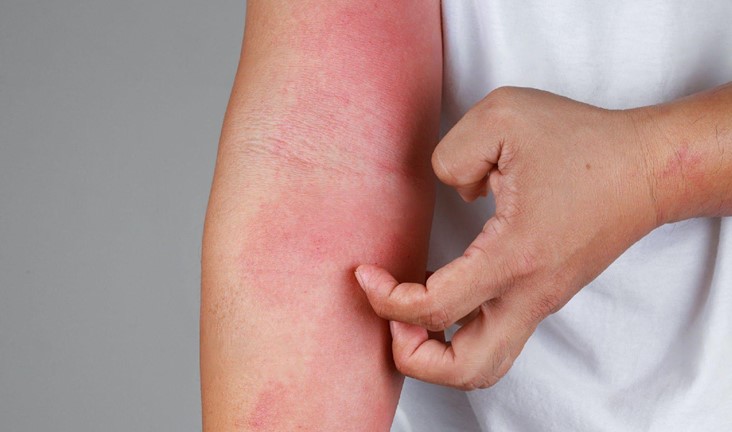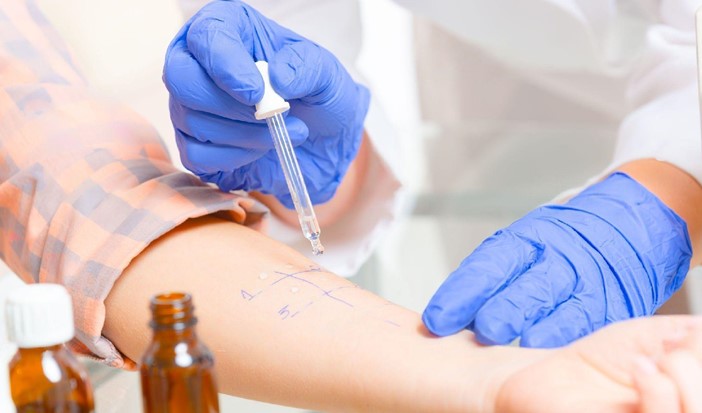
Did you know that skin allergies are one of the most common types of allergies?
In fact, skin allergies account for about 20% of all allergic reactions. While some people may only experience a mild rash or itch, others can suffer from more serious symptoms like angioedema (swelling) and urticaria (hives).
If you are experiencing skin allergy symptoms, it is important to get tested and treated as soon as possible.
This article will discuss the different types of skin allergies and their symptoms, as well as the various treatment options available.
What is Skin Allergy
Skin allergy is a condition that results when the skin comes into contact with an allergen. Allergens can be anything from food to pet dander and can cause a range of symptoms, from mild to life-threatening.
Skin allergy is not just limited to the skin, either – it can also affect other parts of the body, such as the lungs and gastrointestinal tract.
If you are experiencing any skin allergy symptoms, it is important to see a doctor to get tested and treated as soon as possible.
The different types of skin allergies and their symptoms
There are many different types of skin allergies, but the most common include: eczema, hives (urticaria), angioedema, atopic dermatitis, contact dermatitis, drug eruptions.
1. Eczema:
Eczema is a chronic, inflammatory skin condition that results in dry, itchy skin. It can be caused by a number of things, including genetics, allergies, and irritants. Eczema symptoms include:
- dry, itchy skin
- red, inflamed skin
- crusting or scaling of the skin
2. Hives (Urticaria)
Hives are raised, red welts that can occur anywhere on the body. They are often itchy and can be painful. Hives can be caused by a number of things, including infections, stress, and certain medications. Hives symptoms include:
- raised, red welts
- itchiness
- painful swelling
3. Angioedema:
Angioedema is a condition that results in swelling of the deep layers of the skin. It can be caused by a number of things, including genetics, allergies, and certain medications. Angioedema symptoms include:
- swelling of the face,
- lips, tongue, or
- throat
- difficulty breathing
- weakness
4. Atopic Dermatitis:
Atopic dermatitis is a chronic, inflammatory skin condition that is often seen in people with allergies. It can be caused by a number of things, including genetics, allergies, and irritants. Atopic dermatitis symptoms include:
- dry, itchy skin
- red, inflamed skin
- crusting or scaling of the skin
5. Contact Dermatitis:
Contact dermatitis is a condition that results when the skin comes into contact with an irritant or allergen. It can be caused by a number of things, including cosmetics, detergents, and certain medications. Contact dermatitis symptoms include:
- dry, itchy skin
- red, inflamed skin
- blisters
6. Drug Eruptions:
Drug eruptions are a type of allergic reaction that can occur after taking certain medications.
They can be caused by a number of things, including the body’s reaction to the medication, an allergy to the medication, or a combination of both. Drug eruption symptoms include:
- rash
- hives
- itchiness
When these symptoms appear it may mean you have a skin allergy, and would need to get it treated as soon as possible.
However, you cannot know what treatment to get based on symptoms alone. As you can see, most allergies have similar symptoms. So the first ideal step will be to get it diagnosed.
Diagnosing skin allergies

The first step in treating skin allergies is to get a diagnosis. It is a way to determine if you are allergic to a particular substance.
To do this, your doctor will likely ask you about your symptoms and medical history. They may also do a physical exam.
If your doctor suspects you have a skin allergy, they may recommend one or more of the following tests:
1. Skin prick test
This involves placing a small amount of the allergen on the skin, then making a tiny puncture in the skin with a needle. If you are allergic to the substance, you will experience a raised, itchy bump at the site of the puncture.
2. Patch test
This involves placing a small amount of the allergen on a pad that is then applied to the skin. The patch is usually left in place for 48 hours. If you are allergic to the substance, you will experience redness, swelling, and/or itchiness at the site of the patch.
Skin allergy testing is important because it can help you and your doctor determine what substances you are allergic to.
Once your doctor has diagnosed your skin allergy, they will develop a treatment plan.
Various treatment options available for skin allergies
Your doctor may recommend medications. Over-the-counter options include antihistamines and corticosteroid creams. Prescription options include oral corticosteroids and immunosuppressants.
In some cases, skin allergies can be treated with allergy shots (immunotherapy). This is a long-term treatment that can help to reduce or eliminate your symptoms.
Living with skin allergies
The goal of treatment is to relieve your symptoms and prevent future reactions. However, the best course of treatment is avoidance. If you have a skin allergy, it’s important to avoid the allergen.
This can be difficult to do if you don’t know what you’re allergic to. That is why skin allergy testing is extremely vital.
But once you know what you’re allergic to, you can take steps to be cautious.
This may mean carrying an epinephrine auto-injector if you have severe allergies. It also means being careful to avoid potential allergens. Read labels carefully to avoid potential allergens, and be cautious when using new products -particularly if you have sensitive skin.
There is no sure way to prevent skin allergies. However, those are some things you can do to reduce your risk. With proper management, most people with skin allergies can lead normal, active lives.
Myths about skin allergies busted
1. Myth: Skin allergies are rare.
Fact: Skin allergies are actually quite common. In fact, they are one of the most common types of allergies.
2. Myth: Only certain people get skin allergies.
Fact: Anyone can get a skin allergy. However, some people are more susceptible than others. Factors that can increase your risk include having sensitive skin, using certain medications, and being exposed to potential allergens on a regular basis.
3. Myth: Skin allergies are not serious.
Fact: While skin allergies are often not life-threatening, they can be very uncomfortable and inconvenient. In some cases, they can also lead to more serious problems such as skin infections.
4. Myth: There is no treatment for skin allergies.
Fact: There are many different treatment options available for skin allergies. The best course of treatment will depend on the severity of your symptoms and the allergen involved.
5. Myth: Skin allergies can never be cured.
Fact: In many cases, skin allergies can be managed effectively. However, there is no cure for skin allergies. Once you have a skin allergy, you will need to take steps to prevent future reactions.
6. Myth: Skin allergies are contagious
Fact: No, skin allergies are not contagious. However, if you have a skin allergy, you may be more likely to develop other types of allergies.